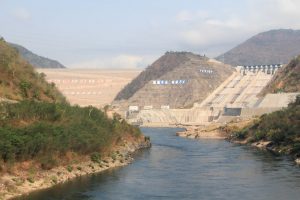A senior American diplomat has criticized China’s string of hydropower dams on the Mekong River, becoming the latest U.S. official to raise alarm about their possible effects on countries downstream. David R. Stilwell, assistant secretary of state for East Asia and the Pacific, accused Beijing of using its 11-dam cascade on the upper reaches of the river to withhold water, “for its own profit [and] at great cost to downstream nations.”
Speaking during a webinar organized jointly by the United States Institute of Peace and the Lee Kuan Yew School of Public Policy at the National University of Singapore, Stilwell said China’s “manipulation” of the Mekong’s flow was an “urgent challenge” for the Association of Southeast Asian Nations (ASEAN).
Originating inside China, where it is known as the Lancang, the Mekong flows through five ASEAN member states before spilling into the South China Sea. This year, the river has been hit by a severe drought, which has left stretches of the river along the border with Laos and Thailand dried up entirely. This followed on the heels of another record dry-spell in 2016. An estimated 60 million people rely on the Mekong and its resources in mainland Southeast Asia.
China’s dams aren’t the only cause of the Mekong’s woes — climate change, El Niño weather patterns, and over-cultivation also play their part — but dams are believed to play an increasingly negative effect on downstream water flows. Stilwell cited a recent report claiming that China’s upstream dams had contributed significantly to the unusually dry conditions downstream.
The report in question was released in April by Eyes on Earth, a U.S.-based research and consulting company, and was commissioned jointly by the U.S. government’s Lower Mekong Initiative (LMI) and the United Nations-backed Sustainable Infrastructure Partnership. The authors of the report found a yawning mismatch between the recent volume of rainfall on the Chinese portion of the Mekong and the water levels downstream. “For six months in 2019, while China received above average precipitation,” it concluded, “its dams held back more water than ever — even as downstream countries suffered through an unprecedented drought.”
Stilwell’s comments reveal the extent to which the Mekong has become a new front for U.S.-China rivalry in Southeast Asia. During an LMI meeting in Bangkok on July 30, Secretary of State Mike Pompeo linked record-low water levels “to China’s decision to shut off water upstream.” The U.S. ambassador to Cambodia has similarly accused China of “hoarding” a life-giving resource.
It also comes in the midst of American moves to counter China’s influence in the lower Mekong region. On September 9, on the sidelines of the upcoming cluster of ASEAN-related meetings, Pompeo will co-chair the inaugural Mekong-U.S. Partnership Ministerial Meeting with the five lower Mekong countries. According to the U.S. State Department, the Mekong-U.S. Partnership will expand on the current LMI mechanism “by strengthening the autonomy, economic independence, and sustainable development of the Mekong partner countries.”
In the escalating U.S.-China rivalry, science itself has become a subject of contestation. A few months after the release of the U.S.-funded Eyes on Earth report, China publicized a rival report, conducted by researchers from Tsinghua University and the China Institute of Water Resources, claiming that China’s dams had actually helped alleviate drought conditions downstream. At the same time China has moved to reassure its Mekong neighbors, promising to share hydrological data gathered on upper reaches of the river.
Whether or not they believe China’s assurances, the downstream countries remain reluctant to join the U.S. in speaking out against China’s likely role in the ongoing drought. Whether in recognition of the fact that they rely on China for access to a life-giving resource, or need Chinese support in building their own hydropower capacity, so far none of the downstream nations have commented publicly in favor of either the American or Chinese study. Either way, the worsening situation on the river — and Washington’s increasing willingness to conscript the issue into its deepening rivalry with Beijing — has put the Mekong and those who rely on it at the center of the brewing rivalry between the two superpowers.

































